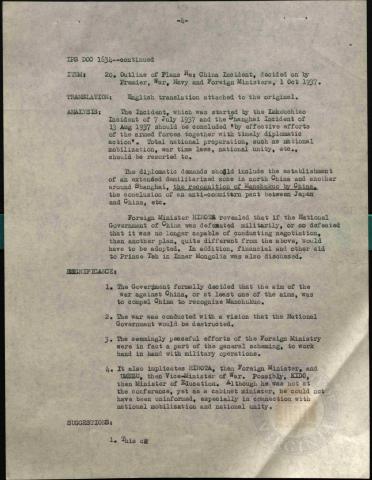
Page 6
| Parent | Report on Unintroduced Evidence -- China Phase |
|---|---|
| Date | 22 April 1947 |
| Language | English |
| Collection | Tavenner Papers & IMTFE Official Records |
| Box | Box 4 |
| Folder | General Reports and Memoranda from September 1947 |
| Repository | University of Virginia Law Library |
ITEM: 20. Outline of Plans China Incident, decided on by
Premier, War, Navy and Foreign Ministers, 1 Oct 1937.
TRANSLATION: English translation attached to the original.
ANALYSIS: The Incident, which was started by the Lukouchiao Incident of 7 July 1937 and the Shanghai Incident of 13 Aug 1937 should be concluded "by effective efforts of the aimed forces together with timely diplomatic action". Total national preparation, such as national mobilization, war time laws, national unity, etc., should be resorted to.
The diplomatic demands should include the establishment of an extended demilitarized zone in north China and another around Shanghai, the recognition of Manchukuo by China. the conclusion of an anti-comintern pact between Japan and China, etc.
Foreign Minister HIROTA revealed that if the National Government of China was defeated militarily, or so defeated that it was no longer capable of conducting negotiation, then another plan, quite different from the above, would have to be adopted. In addition, financial and other aid to Prince Teh in Inner Mongolia was also discussed.
SIGNIFICANCE:
1.The Government formally decided that the aim of the
war against China, or at least one of the aims, was to compel China to recognize Manchukuo.
2.The war was conducted with a vision that the National Government would be destructed.
3.The seemingly peaceful efforts of the Foreign Ministry were in fact a part of the general scheming, to work hand in hand with military operations.
4.It also implicates HIROTA, then Foreign Minister, and
UMEZU, then Vice-Minister of War. Possibly, KIDO, then Minister of Education. Although he was not at the conference, yet as a cabinet minister, he could not have been uninformed, especially in connection with national mobilization and national unity.
SUGGESTIONS:
1. This ca
